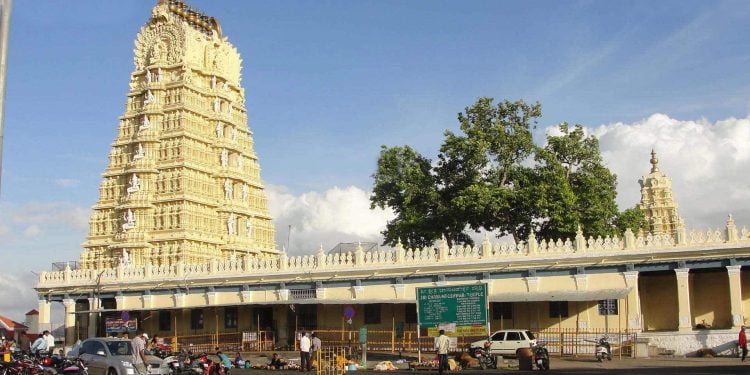The Chamundeshwari Temple is located on the top of Chamundi Hills about 13 km from the palace city of Mysore in the state of Karnataka in India. The temple was named after Chamundeshwari or Durga, the fierce form of Shakti, a tutelary deity held in reverence for centuries by Mysore Maharajas.
Shrine’s History
In the historical background of Chamundi Hills, the contributions made by three dynasties, Hoysala, Vijayanagar and Mysore rulers, are traced. The famous 12th century Hoysala king, Vishnuvardhana, and the 17th century Vijayanagar rulers have made contributions to it. In the Mysore history, an incident relating to Chamaraja Wodeyar, who turned bald after a lightning struck him while going to the temple in 1573 A.D., is narrated. There are also records of gifts made to the temple by the rulers of Mysore.

Architectural Relevance of This Shrine
The temple is a quadrangular structure. Built in Dravidian style, it consists of the Main Doorway, Entrance, Navaranga Hall, Antharala Mantapa, Sanctum Sanctorum, and Prakara. There is a beautiful seven-tier Gopura or pyramidal tower at the entrance and a Vimana atop the sanctum sanctorum. Atop the Shikara, the tower at the entrance, are seven golden Kalashas. Krishnaraja Wodeyar III repaired the shrine in 1827 A.D and built the present beautiful tower at the entrance . Blessed by the Goddess, Krishnaraja Wodeyar, an ardent devotee of the mother Goddess, presented to the temple a Simha-vahana and other animal cars and jewels of value. The cars are used even now for processions on special religious days.
The tower at the entrance has a small image of Lord Ganesha on the doorway. The doorway is silver-plated and has the images of the Goddess in different forms. On either side of the doorway are the images of Dwarapalakas or door-keepers. As one enters inside, on the right-hand side is a small statue of Lord Ganesha, the remover of all obstacles.
After a few steps, there is a flagstaff, the footprints of the Goddess and a small statue of Nandi, facing the sanctum sanctorum. On the right side, before approaching the flagstaff, there is an image of Anjaneya attached to the wall. On either side of this entrance are two Dikpalakas, Nandini and Kamalini. In the Antharala prior to the sacred sanctum sanctorum are the images of Lord Ganesha on the left side and of Bhyrava on the right side.
To the left of Ganesha, there is a beautiful 6-foot statue of Maharaja Krishnaraja Wodeyar III. He is standing with his hands folded in his religious clothes. On either side of him are his three wives, Ramavilasa, Lakshmi Vilas and Krishna Vilas. Their names are carved on the pedestals. In the sanctum sanctorum is the stone statue of the Goddess, Mahisha Mardhini. Having Ashta Bhajans or eight shoulders, she is in a seated posture. According to the local legend, the image was established by sage Markandeya and hence it is said to be very old. The idol of the Goddess is decorated every day and worshipped by a number of priests. The Mysore Maharajas have made a number of valuable gifts to their family deity.
Human and animal sacrifices were in vogue in old times. However, they were totally stopped from the 18th century onwards. Now only coconuts, fruits and flowers are offered. On top of the sanctum sanctorum, a small tower or Vimana is seen. In the Prakara or enclosure, behind the sanctum sanctorum, are small images of a few deities, which are also worshipped. After going round the sanctum sanctorum through this Prakara, a devotee can return to the main entrance, which leads him outside.
With the Goddess residing atop, Chamundi Hills has become a famous religious centre. What was a small temple of a local deity, Chamundi has come to assume great religious significance due to the ardent devotion and development the Mysore Maharajas have contributed to the place? Consequently, Chamundeswari has become a Goddess of great religious tradition and the temple has grown into a big temple assuming importance for all its devotees and others.
Shrine’s Map Location and How to Go There
By Road
KSRTC bus facilities are available every 20 minutes from Mysore city bus stand to Chamundi hill.
By Rail
Mysore is connected with a number of trains to Bangalore. The super fast luxury train the Shatabdi Express connects Mysore to Madras. The quickest and most comfortable way to reach Mysore is via Bangalore.
By Air
The nearest airport to Mysore is Bangalore . All the domestic airlines in the country operate their flights to Bangalore from all the major cities in the country. Some international airlines to have flights to Bangalore. Bangalore is to have an international airport shortly.
Shrine Timings
Abhisheka Timings 6 am to 7.30 am & 6 pm to 7.30 pm Friday 5 am to 6.30 am Darshan & Pooja Timings 7.30 am to 2 pm 3.30 pm to 6 pm 7.30 pm to 9 pm Timings may be changed on Special Days
Extra Information About this Shrine
Homa, Abhisheka, Utsava – Sevas to Divine Mother may please be intimated two days earlier Chamundi Hills are declared as no plastic zone. Devotees are requested not to bring the plastic carry bags and not throw the plastic wastes in the hill area.













































